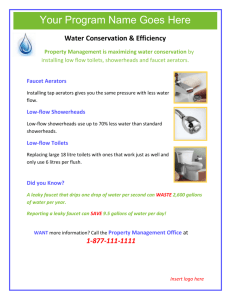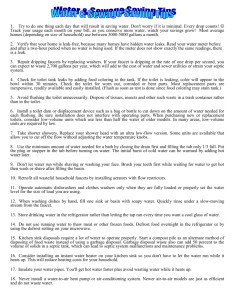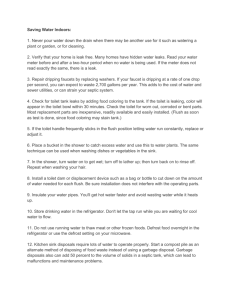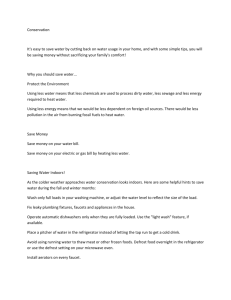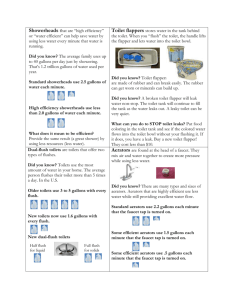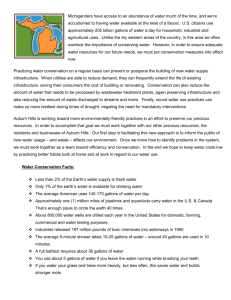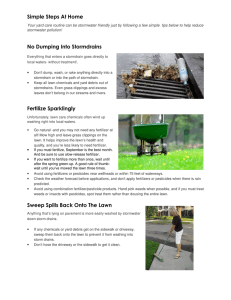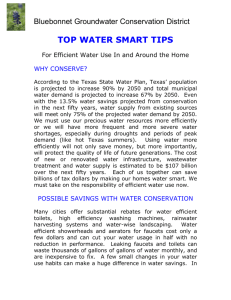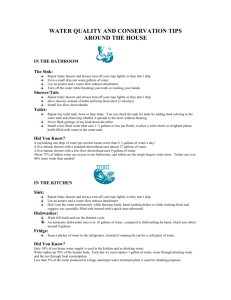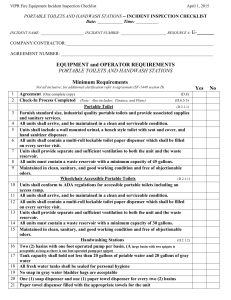Conservation - Water Quality Information for Consumers
advertisement
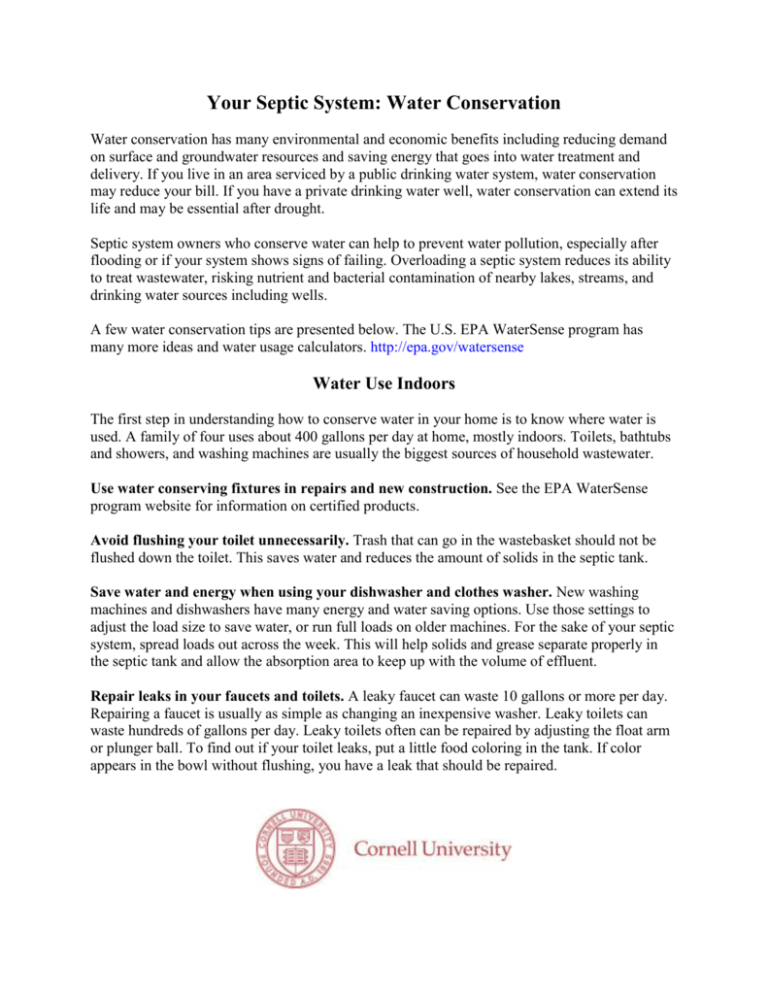
Your Septic System: Water Conservation Water conservation has many environmental and economic benefits including reducing demand on surface and groundwater resources and saving energy that goes into water treatment and delivery. If you live in an area serviced by a public drinking water system, water conservation may reduce your bill. If you have a private drinking water well, water conservation can extend its life and may be essential after drought. Septic system owners who conserve water can help to prevent water pollution, especially after flooding or if your system shows signs of failing. Overloading a septic system reduces its ability to treat wastewater, risking nutrient and bacterial contamination of nearby lakes, streams, and drinking water sources including wells. A few water conservation tips are presented below. The U.S. EPA WaterSense program has many more ideas and water usage calculators. http://epa.gov/watersense Water Use Indoors The first step in understanding how to conserve water in your home is to know where water is used. A family of four uses about 400 gallons per day at home, mostly indoors. Toilets, bathtubs and showers, and washing machines are usually the biggest sources of household wastewater. Use water conserving fixtures in repairs and new construction. See the EPA WaterSense program website for information on certified products. Avoid flushing your toilet unnecessarily. Trash that can go in the wastebasket should not be flushed down the toilet. This saves water and reduces the amount of solids in the septic tank. Save water and energy when using your dishwasher and clothes washer. New washing machines and dishwashers have many energy and water saving options. Use those settings to adjust the load size to save water, or run full loads on older machines. For the sake of your septic system, spread loads out across the week. This will help solids and grease separate properly in the septic tank and allow the absorption area to keep up with the volume of effluent. Repair leaks in your faucets and toilets. A leaky faucet can waste 10 gallons or more per day. Repairing a faucet is usually as simple as changing an inexpensive washer. Leaky toilets can waste hundreds of gallons per day. Leaky toilets often can be repaired by adjusting the float arm or plunger ball. To find out if your toilet leaks, put a little food coloring in the tank. If color appears in the bowl without flushing, you have a leak that should be repaired. Take short showers instead of baths. A five-minute shower uses 10-25 gallons of water, while a bath needs 50 to 60 gallons. Install low flow, water-saving shower heads. This plumbing device reduces the amount of water flowing through your shower by up to 50 percent, but increases its velocity. Install sink faucet aerators. These devices restrict the amount of water going through your faucet by up to 50 percent but add bubbles so the flow of water appears the same. Modify older toilet tanks. Toilet dams for older high-volume flush toilets reduce the amount of water flowing out of the toilet but do not affect its flushing ability. Never use a brick to accomplish the same effect – particles from it could harm your plumbing; a sealed plastic container filled with water is a better option. Water Use Outdoors Watering lawns and gardens and washing cars account for most of the water used outdoors. Although this water will not go through your septic tank, it is important to protect the absorption area from excess water so that it can properly treat your household wastewater. The other benefits of water conservation also apply. Water your lawn and garden only when necessary. Water your lawn when it begins to show signs of wilting – when the grass does not spring back when you step on it – rather than on a regular schedule. Consider using a drip irrigation system in your garden. Your lawn may turn brown in the middle of the summer, but this does not mean that it is dead. Rather, the grass is dormant and will grow when rain and cooler weather return. Mowing the grass too short can cause roots to die back. The Cornell Turfgrass Program has more information on lawn care http://www.hort.cornell.edu/turf Use plant varieties that are well adapted to your locality and soil conditions. Less suitable varieties may need greater amounts of fertilizer and/or water just to stay alive. Contact your local Cooperative Extension office for recommendations or referrals to Master Gardeners. Attach a pistol-type sprayer to the end of your garden hose. It enables you to adjust the flow rate of flow and temporarily shut off the water while you are between tasks. The original version of this publication was developed by Cornell Cooperative Extension (CCE) via a grant from the NYS Water Resources Institute with funds provided by the NY State Legislature through the Dept. of Agriculture and Markets. The project team included A. Meyer, M. Keith, J. Saumier, and M. Shortlidge of Dutchess, Putnam, Rockland, and Westchester Counties. It was adapted from a Michigan State University Cooperative Extension System bulletin by D. Solomon and E. Dersch. It was revised by A. Galford with input from county and NYS health departments and the CCE Water Resources PWT. This material is based upon work supported by Smith-Lever funds from the National Institute of Food and Agriculture, U.S. Department of Agriculture. Any opinions, findings, conclusions, or recommendations expressed in this publication are those of the authors and do not necessarily reflect the view of the U.S. Dept. of Agriculture. Printed 01/2013.
